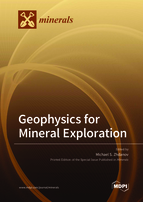Geophysics for Mineral Exploration
A special issue of Minerals (ISSN 2075-163X). This special issue belongs to the section "Mineral Deposits".
Deadline for manuscript submissions: closed (31 October 2020) | Viewed by 43033
Special Issue Editor
Interests: theoretical and applied geophysics; inverse theory; joint inversion; mineral exploration; electromagnetic, gravity, magnetic, and seismic methods
Special Issues, Collections and Topics in MDPI journals
Special Issue Information
Dear Colleagues,
Exploration geophysics plays a major role in unlocking mineral reserves. It is well recognized that many easily-discovered large mineral deposits with a strong geophysical signature have been already identified. Future discoveries present significant challengers being located undercover, in remote areas, with less prominent geophysical signals. The modern-day challenges of exploration require developing novel geophysical techniques, which improve exploration success and lead to new discoveries. This Special Issue invites papers which focus on emerging geophysical techniques for mineral exploration, novel interpretation methods, including joint inversion of multiphysics data, and challenging case studies.
Prof. Michael S. Zhdanov
Guest Editor
Manuscript Submission Information
Manuscripts should be submitted online at www.mdpi.com by registering and logging in to this website. Once you are registered, click here to go to the submission form. Manuscripts can be submitted until the deadline. All submissions that pass pre-check are peer-reviewed. Accepted papers will be published continuously in the journal (as soon as accepted) and will be listed together on the special issue website. Research articles, review articles as well as short communications are invited. For planned papers, a title and short abstract (about 100 words) can be sent to the Editorial Office for announcement on this website.
Submitted manuscripts should not have been published previously, nor be under consideration for publication elsewhere (except conference proceedings papers). All manuscripts are thoroughly refereed through a single-blind peer-review process. A guide for authors and other relevant information for submission of manuscripts is available on the Instructions for Authors page. Minerals is an international peer-reviewed open access monthly journal published by MDPI.
Please visit the Instructions for Authors page before submitting a manuscript. The Article Processing Charge (APC) for publication in this open access journal is 2400 CHF (Swiss Francs). Submitted papers should be well formatted and use good English. Authors may use MDPI's English editing service prior to publication or during author revisions.
Keywords
- Rock physics
- Gravity, magnetic, and electromagnetic methods
- Induced polarization
- Seismic methods
- Ground and downhole geophysics
- Advances in airborne geophysics
- Modeling and inversion
- Joint inversion of multiphysics data
- Exploration under cover
- Deep penetrating geophysical methods
- Case studies






